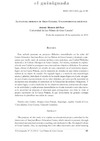Identificador persistente para citar o vincular este elemento:
https://accedacris.ulpgc.es/jspui/handle/10553/12280
| Campo DC | Valor | idioma |
|---|---|---|
| dc.contributor.author | Montero del Pozo, Antonio | en_US |
| dc.date.accessioned | 2014-10-03T02:30:23Z | - |
| dc.date.accessioned | 2018-03-15T14:28:16Z | - |
| dc.date.available | 2014-10-03T02:30:23Z | - |
| dc.date.available | 2018-03-15T14:28:16Z | - |
| dc.date.issued | 2012 | en_US |
| dc.identifier.issn | 0213-0610 | en_US |
| dc.identifier.other | WoS | - |
| dc.identifier.uri | https://accedacris.ulpgc.es/handle/10553/12280 | - |
| dc.description.abstract | Este artículo presenta un proyecto didáctico materializado en las aulas del Centro Educativo San Juan Bosco de Las Palmas de Gran Canaria y destinado a presentar, por medio tanto de sesiones teóricas como prácticas, una Unidad Didáctica dedicada a la Cultura Aborigen de Gran Canaria. Así mismo, mediante la explicación de esta Unidad se persiguen otros innovadores objetivos didácticos. En primer lugar, ofrecer al alumnado un estudio de caso, encarnado en el yacimiento arqueológico de La Cueva Pintada, con la intención de dotarles de una visión concreta y realista de su objeto de estudio. En segundo lugar, y a través de una metodología amena y práctica, introducir el estudio de la ciencia arqueológica en el aula, abogando por el justo reconocimiento de su valor didáctico, así como por la necesidad de incorporar esta disciplina al currículum de la Educación Secundaria Obligatoria. Y en tercer lugar, y como trasfondo de los objetivos anteriores, estructurar el conjunto de actividades y explicaciones desarrolladas en el aula tomando como idea rectora la necesidad de preparar al alumnado para protagonizar con éxito la visita al propio yacimiento de la Cueva Pintada, lo que demostraría las grandes ventajas didácticas de planificar una salida de campo. | en_US |
| dc.description.abstract | The purpose of this study is to explain an educational project, embodied in the classrooms of San Juan Bosco Education Center, which intends to present, through theoretical and practical sessions a teaching unit dedicated to the Aboriginal Culture of Gran Canaria. Also, by explaining this Unit other innovative and useful learning objectives are pursued. Firstly, I plan to give my students a case study, embodied in the archaeological site of “La Cueva Pintada” in order to provide them with a concrete and realistic vision of this object of study. Secondly, and through an entertaining and practical methodology, I try to introduce the study of archeology in the classroom, advocating, reconditioning its educational value and showing the need to incorporate this discipline into the curriculum of ESO. And thirdly, I have structured a set of activities and explanations developed in the classroom taking as the guiding principle the need to prepare my students for the visit to the site of “La Cueva Pintada”, demonstrating the educational advantages of planning a field trip. | en_US |
| dc.format | - | |
| dc.language | spa | en_US |
| dc.relation.ispartof | El Guiniguada | en_US |
| dc.source | Guiniguada [ISSN 0213-0610], v. 21, p. 65-83 | en_US |
| dc.subject | 58 Pedagogía | en_US |
| dc.subject | 531204 Educación | en_US |
| dc.subject.other | Cultura Aborigen | en_US |
| dc.subject.other | Cueva Pintada | en_US |
| dc.subject.other | Arqueología | en_US |
| dc.subject.other | Agáldar | en_US |
| dc.subject.other | Visita didáctica | en_US |
| dc.subject.other | Aboriginal culture | en_US |
| dc.subject.other | Archeology | en_US |
| dc.subject.other | Educational visit | en_US |
| dc.subject.other | Secondary Education | en_US |
| dc.title | La cultura aborigen de Gran Canaria. Una experiencia didáctica | en_US |
| dc.title.alternative | The Aboriginal Culture Of Gran Canaria. A Didactic Experience | en_US |
| dc.type | info:eu-repo/semantics/article | en_US |
| dc.type | Article | en_US |
| dc.identifier.isi | 000215085000004 | - |
| dc.compliance.driver | 1 | - |
| dc.identifier.absysnet | 235347 | - |
| dc.identifier.eissn | 2386-3374 | - |
| dc.description.lastpage | 83 | en_US |
| dc.description.firstpage | 65 | en_US |
| dc.relation.volume | 21 | en_US |
| dc.investigacion | Artes y Humanidades | en_US |
| dc.rights.accessrights | info:eu-repo/semantics/openAccess | - |
| dc.type2 | Artículo | en_US |
| dc.contributor.daisngid | 21302925 | - |
| dc.description.numberofpages | 19 | en_US |
| dc.utils.revision | Sí | en_US |
| dc.contributor.wosstandard | WOS:del Pozo, AM | - |
| dc.date.coverdate | 2012 | en_US |
| dc.identifier.ulpgc | Sí | es |
| dc.description.sellofecyt | Sello FECYT | |
| dc.description.esci | ESCI | |
| dc.description.erihplus | ERIH PLUS | |
| item.fulltext | Con texto completo | - |
| item.grantfulltext | open | - |
| Colección: | Guiniguada. 2ª Etapa. n.21, 2012 Artículos | |
Visitas
152
actualizado el 17-ago-2024
Descargas
468
actualizado el 17-ago-2024
Google ScholarTM
Verifica
Comparte
Exporta metadatos
Los elementos en ULPGC accedaCRIS están protegidos por derechos de autor con todos los derechos reservados, a menos que se indique lo contrario.
